CXA110 Report: Health Promotion Principles, University Name
VerifiedAdded on 2023/06/07
|9
|1819
|287
Report
AI Summary
This report provides an analysis of health promotion principles, drawing on two articles that address health interventions for the homeless and people affected by armed conflict. The report begins with an executive summary, followed by an introduction that defines health promotion and its significance beyond individual behavior. It then compares and contrasts the two articles, highlighting similarities such as the focus on regions of major conflict and concern, and dissimilarities in their approaches. The report delves into key principles such as community resources, interpersonal relationships, and international humanitarian law. A reflection section discusses the alignment of these principles with the author's values, emphasizing community care, primary healthcare services, and the importance of respectful patient communication. The report concludes that both homelessness and armed conflict are major public health problems that demand comprehensive health promotion strategies that consider economic, social, mental, and physical dimensions of health.
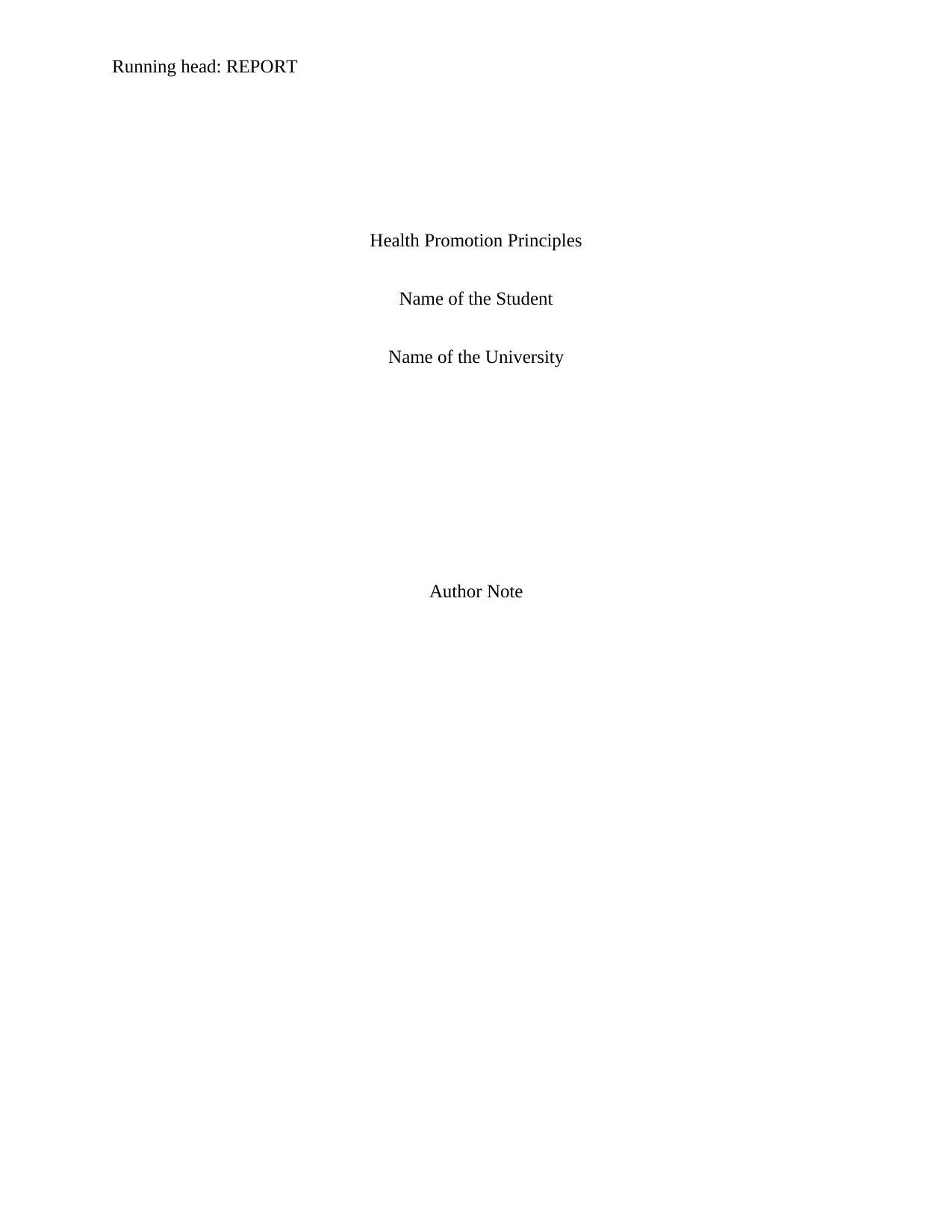
Running head: REPORT
Health Promotion Principles
Name of the Student
Name of the University
Author Note
Health Promotion Principles
Name of the Student
Name of the University
Author Note
Paraphrase This Document
Need a fresh take? Get an instant paraphrase of this document with our AI Paraphraser
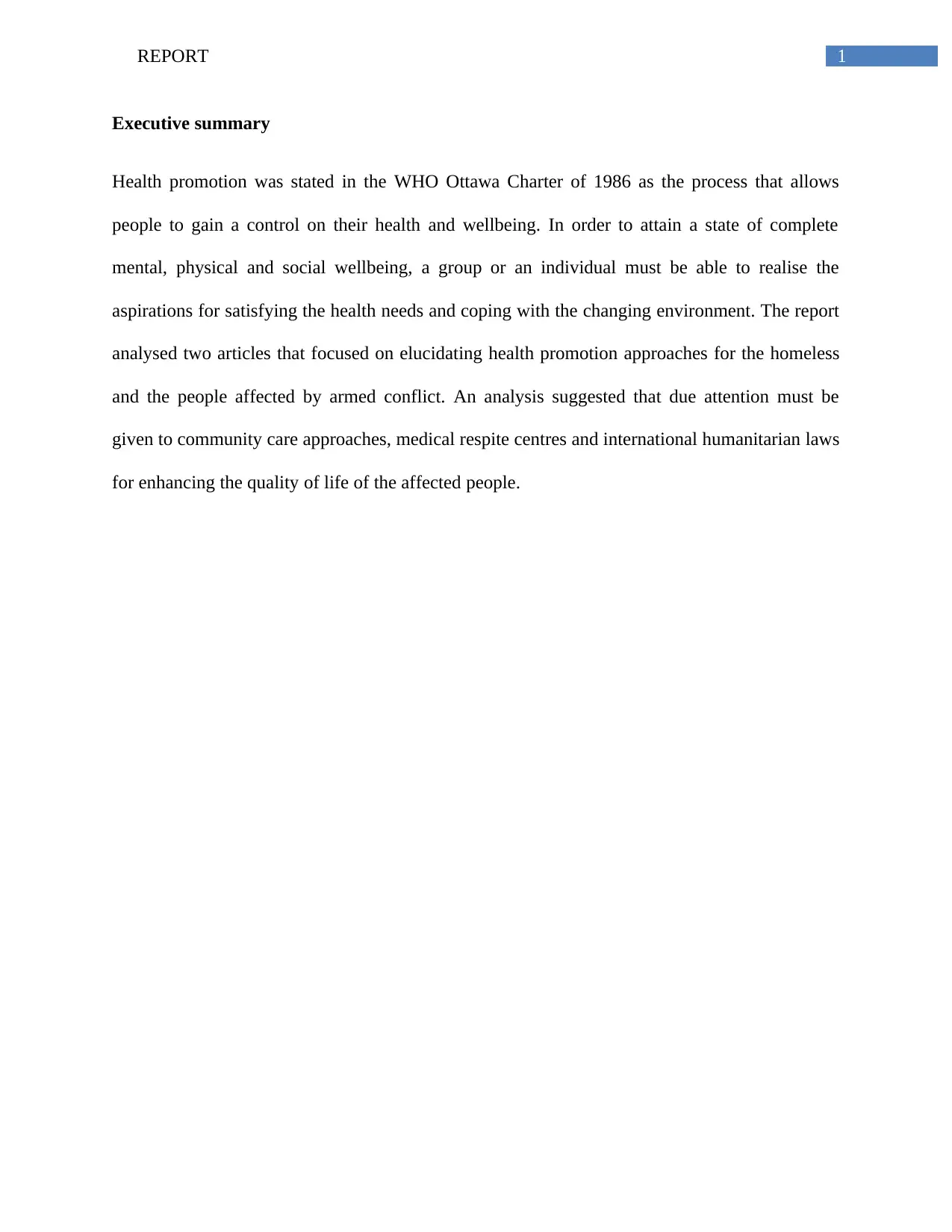
1REPORT
Executive summary
Health promotion was stated in the WHO Ottawa Charter of 1986 as the process that allows
people to gain a control on their health and wellbeing. In order to attain a state of complete
mental, physical and social wellbeing, a group or an individual must be able to realise the
aspirations for satisfying the health needs and coping with the changing environment. The report
analysed two articles that focused on elucidating health promotion approaches for the homeless
and the people affected by armed conflict. An analysis suggested that due attention must be
given to community care approaches, medical respite centres and international humanitarian laws
for enhancing the quality of life of the affected people.
Executive summary
Health promotion was stated in the WHO Ottawa Charter of 1986 as the process that allows
people to gain a control on their health and wellbeing. In order to attain a state of complete
mental, physical and social wellbeing, a group or an individual must be able to realise the
aspirations for satisfying the health needs and coping with the changing environment. The report
analysed two articles that focused on elucidating health promotion approaches for the homeless
and the people affected by armed conflict. An analysis suggested that due attention must be
given to community care approaches, medical respite centres and international humanitarian laws
for enhancing the quality of life of the affected people.
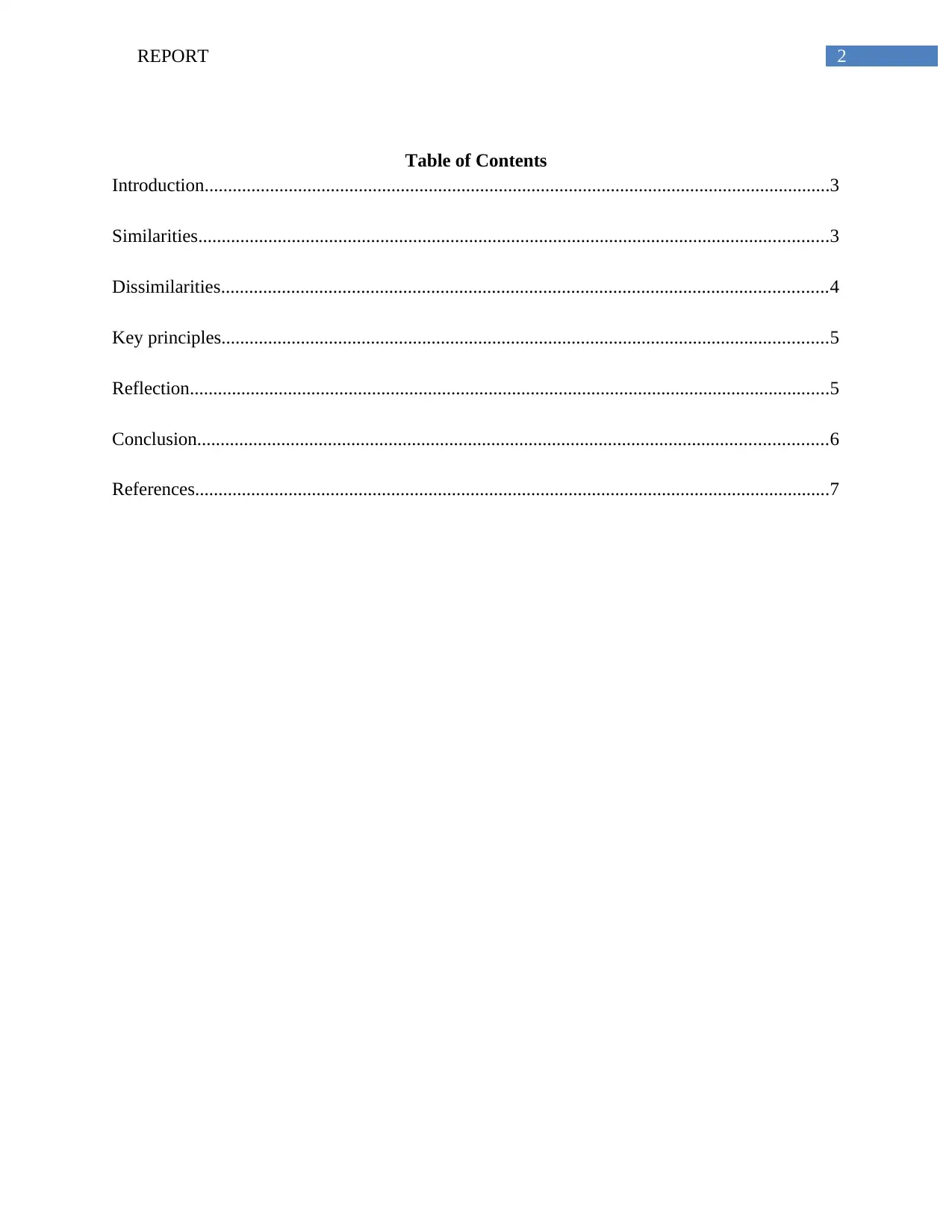
2REPORT
Table of Contents
Introduction......................................................................................................................................3
Similarities.......................................................................................................................................3
Dissimilarities..................................................................................................................................4
Key principles..................................................................................................................................5
Reflection.........................................................................................................................................5
Conclusion.......................................................................................................................................6
References........................................................................................................................................7
Table of Contents
Introduction......................................................................................................................................3
Similarities.......................................................................................................................................3
Dissimilarities..................................................................................................................................4
Key principles..................................................................................................................................5
Reflection.........................................................................................................................................5
Conclusion.......................................................................................................................................6
References........................................................................................................................................7
⊘ This is a preview!⊘
Do you want full access?
Subscribe today to unlock all pages.

Trusted by 1+ million students worldwide
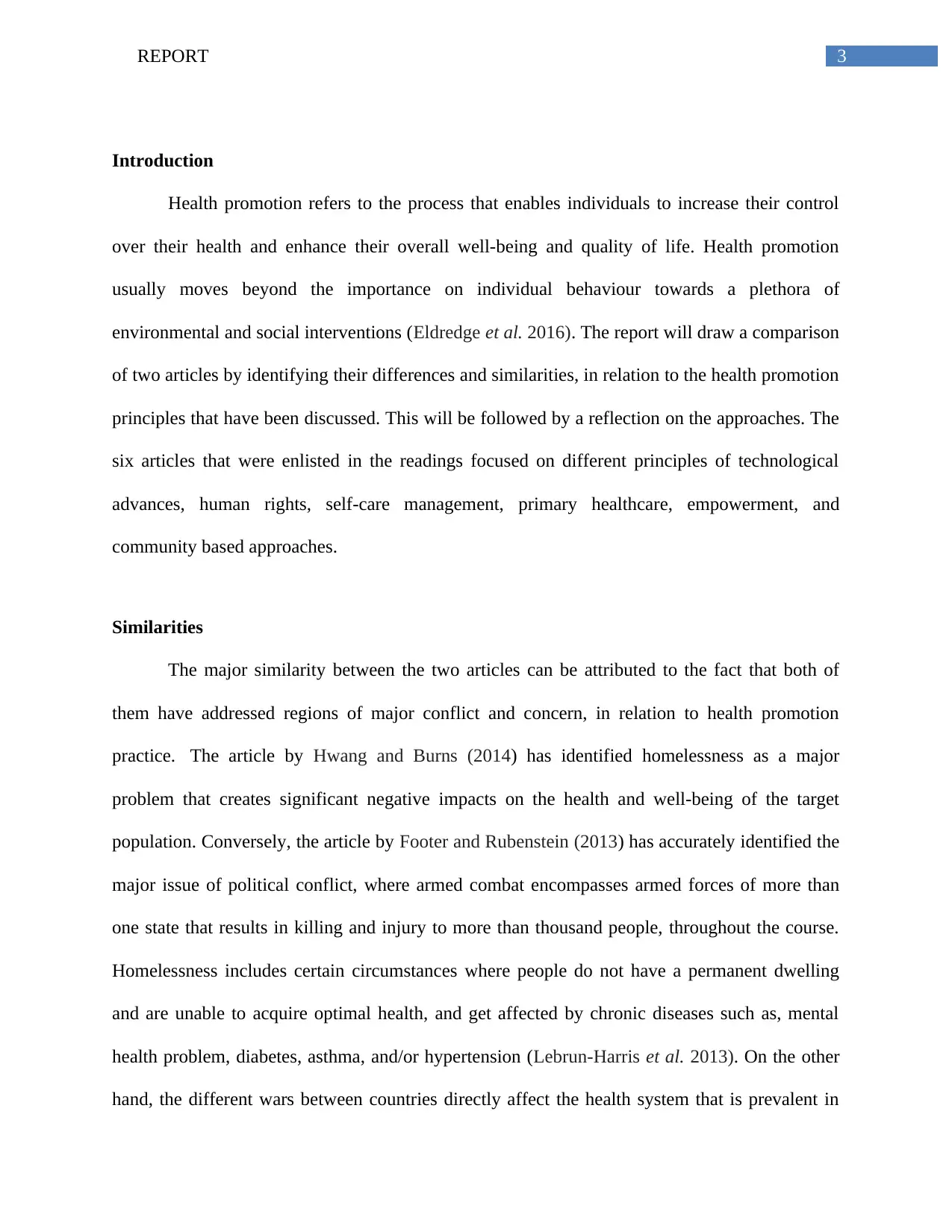
3REPORT
Introduction
Health promotion refers to the process that enables individuals to increase their control
over their health and enhance their overall well-being and quality of life. Health promotion
usually moves beyond the importance on individual behaviour towards a plethora of
environmental and social interventions (Eldredge et al. 2016). The report will draw a comparison
of two articles by identifying their differences and similarities, in relation to the health promotion
principles that have been discussed. This will be followed by a reflection on the approaches. The
six articles that were enlisted in the readings focused on different principles of technological
advances, human rights, self-care management, primary healthcare, empowerment, and
community based approaches.
Similarities
The major similarity between the two articles can be attributed to the fact that both of
them have addressed regions of major conflict and concern, in relation to health promotion
practice. The article by Hwang and Burns (2014) has identified homelessness as a major
problem that creates significant negative impacts on the health and well-being of the target
population. Conversely, the article by Footer and Rubenstein (2013) has accurately identified the
major issue of political conflict, where armed combat encompasses armed forces of more than
one state that results in killing and injury to more than thousand people, throughout the course.
Homelessness includes certain circumstances where people do not have a permanent dwelling
and are unable to acquire optimal health, and get affected by chronic diseases such as, mental
health problem, diabetes, asthma, and/or hypertension (Lebrun‐Harris et al. 2013). On the other
hand, the different wars between countries directly affect the health system that is prevalent in
Introduction
Health promotion refers to the process that enables individuals to increase their control
over their health and enhance their overall well-being and quality of life. Health promotion
usually moves beyond the importance on individual behaviour towards a plethora of
environmental and social interventions (Eldredge et al. 2016). The report will draw a comparison
of two articles by identifying their differences and similarities, in relation to the health promotion
principles that have been discussed. This will be followed by a reflection on the approaches. The
six articles that were enlisted in the readings focused on different principles of technological
advances, human rights, self-care management, primary healthcare, empowerment, and
community based approaches.
Similarities
The major similarity between the two articles can be attributed to the fact that both of
them have addressed regions of major conflict and concern, in relation to health promotion
practice. The article by Hwang and Burns (2014) has identified homelessness as a major
problem that creates significant negative impacts on the health and well-being of the target
population. Conversely, the article by Footer and Rubenstein (2013) has accurately identified the
major issue of political conflict, where armed combat encompasses armed forces of more than
one state that results in killing and injury to more than thousand people, throughout the course.
Homelessness includes certain circumstances where people do not have a permanent dwelling
and are unable to acquire optimal health, and get affected by chronic diseases such as, mental
health problem, diabetes, asthma, and/or hypertension (Lebrun‐Harris et al. 2013). On the other
hand, the different wars between countries directly affect the health system that is prevalent in
Paraphrase This Document
Need a fresh take? Get an instant paraphrase of this document with our AI Paraphraser
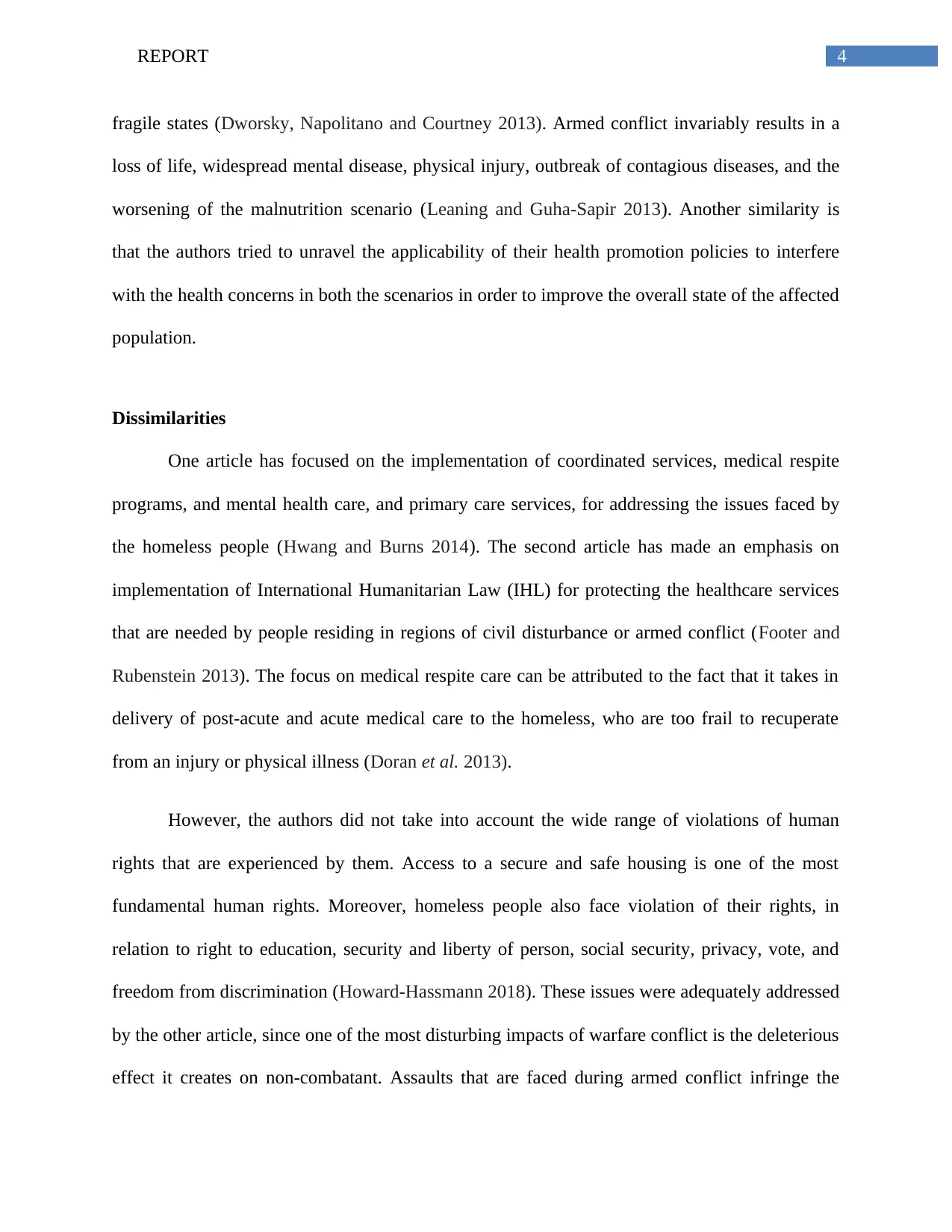
4REPORT
fragile states (Dworsky, Napolitano and Courtney 2013). Armed conflict invariably results in a
loss of life, widespread mental disease, physical injury, outbreak of contagious diseases, and the
worsening of the malnutrition scenario (Leaning and Guha-Sapir 2013). Another similarity is
that the authors tried to unravel the applicability of their health promotion policies to interfere
with the health concerns in both the scenarios in order to improve the overall state of the affected
population.
Dissimilarities
One article has focused on the implementation of coordinated services, medical respite
programs, and mental health care, and primary care services, for addressing the issues faced by
the homeless people (Hwang and Burns 2014). The second article has made an emphasis on
implementation of International Humanitarian Law (IHL) for protecting the healthcare services
that are needed by people residing in regions of civil disturbance or armed conflict (Footer and
Rubenstein 2013). The focus on medical respite care can be attributed to the fact that it takes in
delivery of post-acute and acute medical care to the homeless, who are too frail to recuperate
from an injury or physical illness (Doran et al. 2013).
However, the authors did not take into account the wide range of violations of human
rights that are experienced by them. Access to a secure and safe housing is one of the most
fundamental human rights. Moreover, homeless people also face violation of their rights, in
relation to right to education, security and liberty of person, social security, privacy, vote, and
freedom from discrimination (Howard-Hassmann 2018). These issues were adequately addressed
by the other article, since one of the most disturbing impacts of warfare conflict is the deleterious
effect it creates on non-combatant. Assaults that are faced during armed conflict infringe the
fragile states (Dworsky, Napolitano and Courtney 2013). Armed conflict invariably results in a
loss of life, widespread mental disease, physical injury, outbreak of contagious diseases, and the
worsening of the malnutrition scenario (Leaning and Guha-Sapir 2013). Another similarity is
that the authors tried to unravel the applicability of their health promotion policies to interfere
with the health concerns in both the scenarios in order to improve the overall state of the affected
population.
Dissimilarities
One article has focused on the implementation of coordinated services, medical respite
programs, and mental health care, and primary care services, for addressing the issues faced by
the homeless people (Hwang and Burns 2014). The second article has made an emphasis on
implementation of International Humanitarian Law (IHL) for protecting the healthcare services
that are needed by people residing in regions of civil disturbance or armed conflict (Footer and
Rubenstein 2013). The focus on medical respite care can be attributed to the fact that it takes in
delivery of post-acute and acute medical care to the homeless, who are too frail to recuperate
from an injury or physical illness (Doran et al. 2013).
However, the authors did not take into account the wide range of violations of human
rights that are experienced by them. Access to a secure and safe housing is one of the most
fundamental human rights. Moreover, homeless people also face violation of their rights, in
relation to right to education, security and liberty of person, social security, privacy, vote, and
freedom from discrimination (Howard-Hassmann 2018). These issues were adequately addressed
by the other article, since one of the most disturbing impacts of warfare conflict is the deleterious
effect it creates on non-combatant. Assaults that are faced during armed conflict infringe the
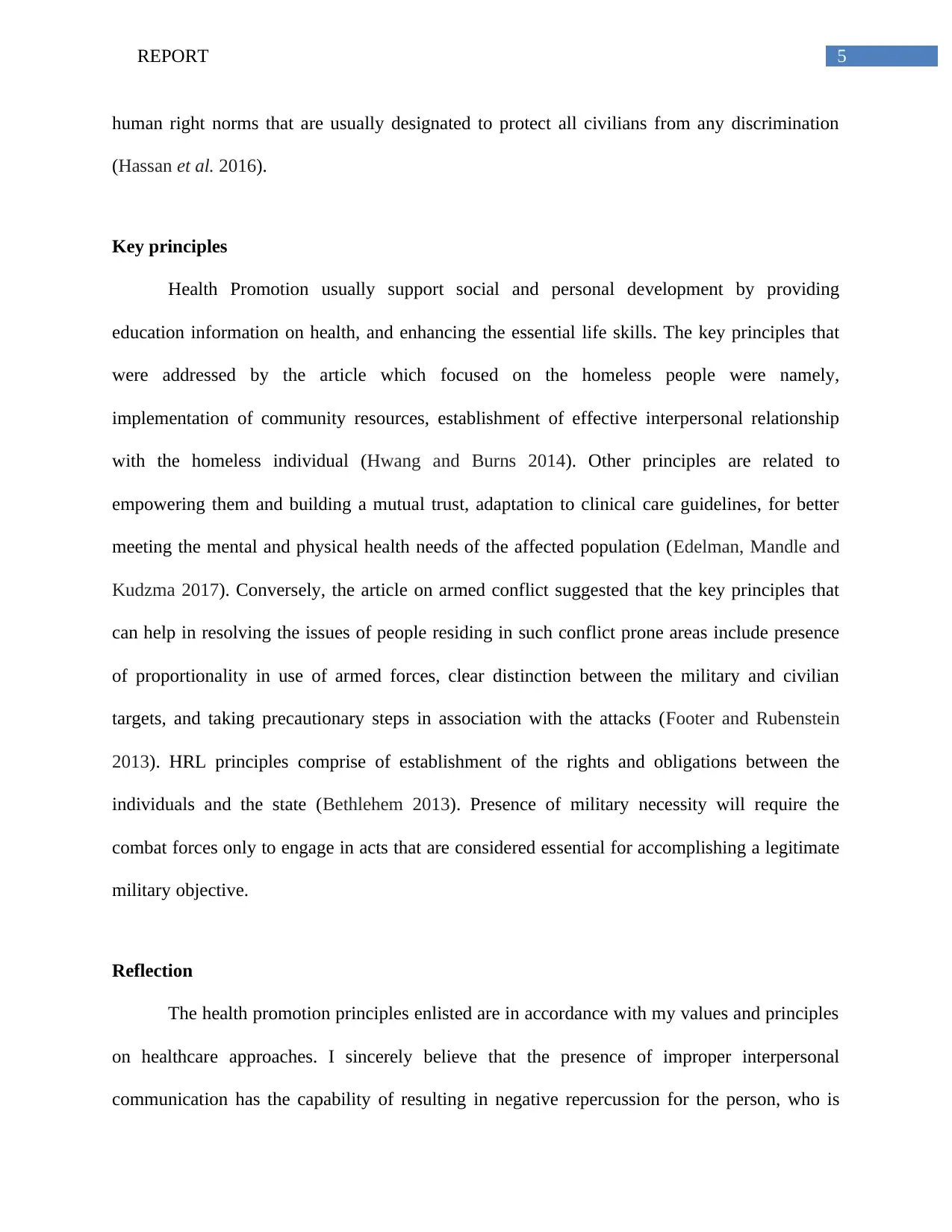
5REPORT
human right norms that are usually designated to protect all civilians from any discrimination
(Hassan et al. 2016).
Key principles
Health Promotion usually support social and personal development by providing
education information on health, and enhancing the essential life skills. The key principles that
were addressed by the article which focused on the homeless people were namely,
implementation of community resources, establishment of effective interpersonal relationship
with the homeless individual (Hwang and Burns 2014). Other principles are related to
empowering them and building a mutual trust, adaptation to clinical care guidelines, for better
meeting the mental and physical health needs of the affected population (Edelman, Mandle and
Kudzma 2017). Conversely, the article on armed conflict suggested that the key principles that
can help in resolving the issues of people residing in such conflict prone areas include presence
of proportionality in use of armed forces, clear distinction between the military and civilian
targets, and taking precautionary steps in association with the attacks (Footer and Rubenstein
2013). HRL principles comprise of establishment of the rights and obligations between the
individuals and the state (Bethlehem 2013). Presence of military necessity will require the
combat forces only to engage in acts that are considered essential for accomplishing a legitimate
military objective.
Reflection
The health promotion principles enlisted are in accordance with my values and principles
on healthcare approaches. I sincerely believe that the presence of improper interpersonal
communication has the capability of resulting in negative repercussion for the person, who is
human right norms that are usually designated to protect all civilians from any discrimination
(Hassan et al. 2016).
Key principles
Health Promotion usually support social and personal development by providing
education information on health, and enhancing the essential life skills. The key principles that
were addressed by the article which focused on the homeless people were namely,
implementation of community resources, establishment of effective interpersonal relationship
with the homeless individual (Hwang and Burns 2014). Other principles are related to
empowering them and building a mutual trust, adaptation to clinical care guidelines, for better
meeting the mental and physical health needs of the affected population (Edelman, Mandle and
Kudzma 2017). Conversely, the article on armed conflict suggested that the key principles that
can help in resolving the issues of people residing in such conflict prone areas include presence
of proportionality in use of armed forces, clear distinction between the military and civilian
targets, and taking precautionary steps in association with the attacks (Footer and Rubenstein
2013). HRL principles comprise of establishment of the rights and obligations between the
individuals and the state (Bethlehem 2013). Presence of military necessity will require the
combat forces only to engage in acts that are considered essential for accomplishing a legitimate
military objective.
Reflection
The health promotion principles enlisted are in accordance with my values and principles
on healthcare approaches. I sincerely believe that the presence of improper interpersonal
communication has the capability of resulting in negative repercussion for the person, who is
⊘ This is a preview!⊘
Do you want full access?
Subscribe today to unlock all pages.

Trusted by 1+ million students worldwide
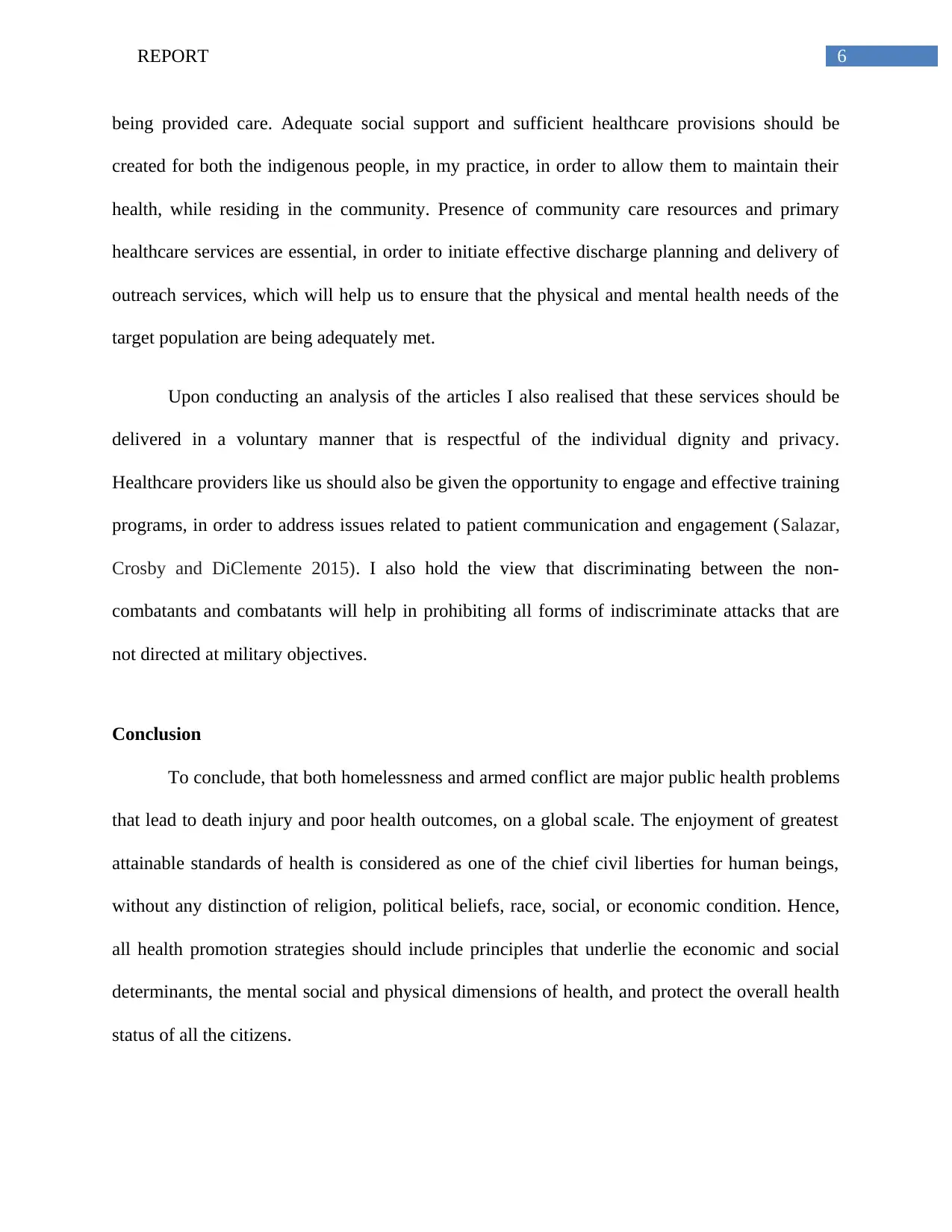
6REPORT
being provided care. Adequate social support and sufficient healthcare provisions should be
created for both the indigenous people, in my practice, in order to allow them to maintain their
health, while residing in the community. Presence of community care resources and primary
healthcare services are essential, in order to initiate effective discharge planning and delivery of
outreach services, which will help us to ensure that the physical and mental health needs of the
target population are being adequately met.
Upon conducting an analysis of the articles I also realised that these services should be
delivered in a voluntary manner that is respectful of the individual dignity and privacy.
Healthcare providers like us should also be given the opportunity to engage and effective training
programs, in order to address issues related to patient communication and engagement (Salazar,
Crosby and DiClemente 2015). I also hold the view that discriminating between the non-
combatants and combatants will help in prohibiting all forms of indiscriminate attacks that are
not directed at military objectives.
Conclusion
To conclude, that both homelessness and armed conflict are major public health problems
that lead to death injury and poor health outcomes, on a global scale. The enjoyment of greatest
attainable standards of health is considered as one of the chief civil liberties for human beings,
without any distinction of religion, political beliefs, race, social, or economic condition. Hence,
all health promotion strategies should include principles that underlie the economic and social
determinants, the mental social and physical dimensions of health, and protect the overall health
status of all the citizens.
being provided care. Adequate social support and sufficient healthcare provisions should be
created for both the indigenous people, in my practice, in order to allow them to maintain their
health, while residing in the community. Presence of community care resources and primary
healthcare services are essential, in order to initiate effective discharge planning and delivery of
outreach services, which will help us to ensure that the physical and mental health needs of the
target population are being adequately met.
Upon conducting an analysis of the articles I also realised that these services should be
delivered in a voluntary manner that is respectful of the individual dignity and privacy.
Healthcare providers like us should also be given the opportunity to engage and effective training
programs, in order to address issues related to patient communication and engagement (Salazar,
Crosby and DiClemente 2015). I also hold the view that discriminating between the non-
combatants and combatants will help in prohibiting all forms of indiscriminate attacks that are
not directed at military objectives.
Conclusion
To conclude, that both homelessness and armed conflict are major public health problems
that lead to death injury and poor health outcomes, on a global scale. The enjoyment of greatest
attainable standards of health is considered as one of the chief civil liberties for human beings,
without any distinction of religion, political beliefs, race, social, or economic condition. Hence,
all health promotion strategies should include principles that underlie the economic and social
determinants, the mental social and physical dimensions of health, and protect the overall health
status of all the citizens.
Paraphrase This Document
Need a fresh take? Get an instant paraphrase of this document with our AI Paraphraser
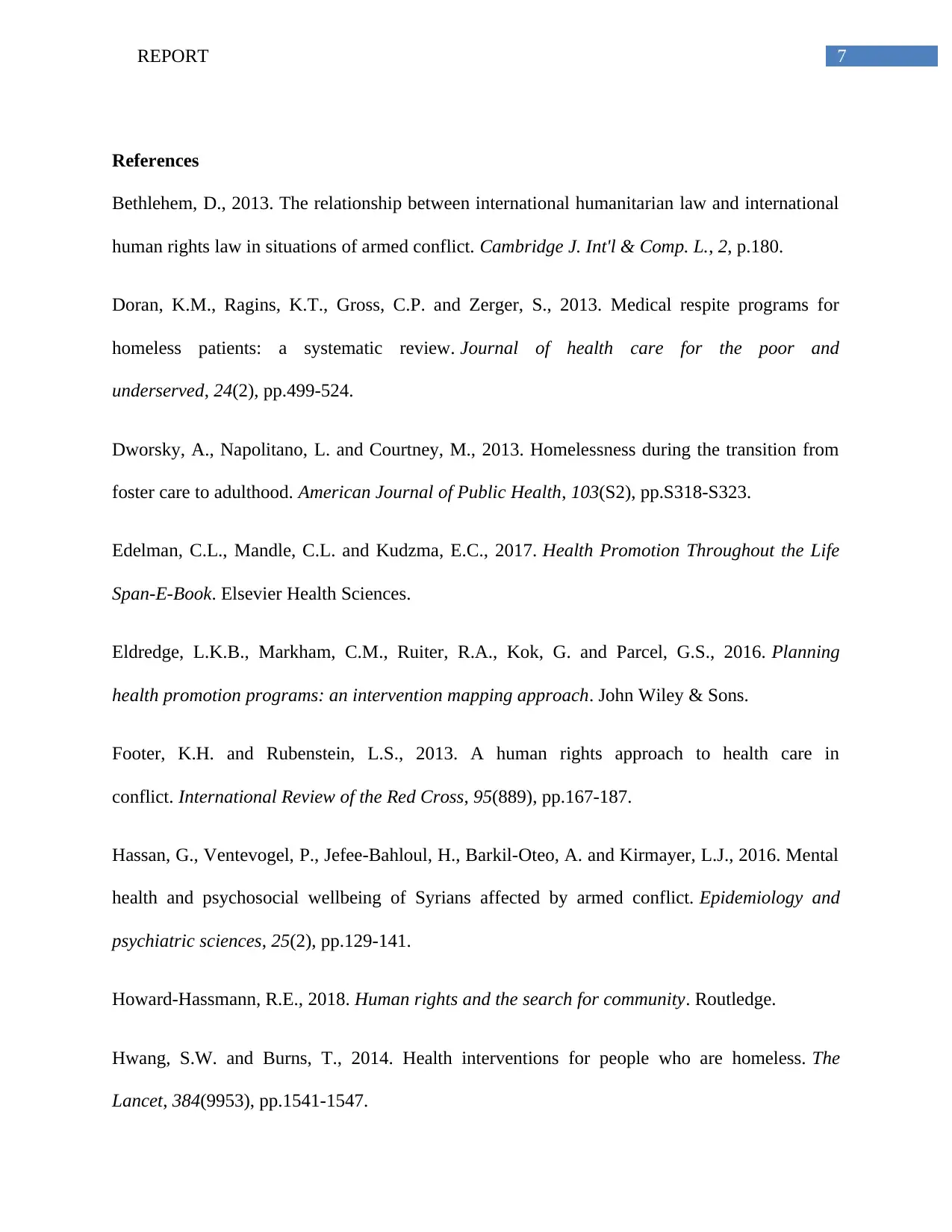
7REPORT
References
Bethlehem, D., 2013. The relationship between international humanitarian law and international
human rights law in situations of armed conflict. Cambridge J. Int'l & Comp. L., 2, p.180.
Doran, K.M., Ragins, K.T., Gross, C.P. and Zerger, S., 2013. Medical respite programs for
homeless patients: a systematic review. Journal of health care for the poor and
underserved, 24(2), pp.499-524.
Dworsky, A., Napolitano, L. and Courtney, M., 2013. Homelessness during the transition from
foster care to adulthood. American Journal of Public Health, 103(S2), pp.S318-S323.
Edelman, C.L., Mandle, C.L. and Kudzma, E.C., 2017. Health Promotion Throughout the Life
Span-E-Book. Elsevier Health Sciences.
Eldredge, L.K.B., Markham, C.M., Ruiter, R.A., Kok, G. and Parcel, G.S., 2016. Planning
health promotion programs: an intervention mapping approach. John Wiley & Sons.
Footer, K.H. and Rubenstein, L.S., 2013. A human rights approach to health care in
conflict. International Review of the Red Cross, 95(889), pp.167-187.
Hassan, G., Ventevogel, P., Jefee-Bahloul, H., Barkil-Oteo, A. and Kirmayer, L.J., 2016. Mental
health and psychosocial wellbeing of Syrians affected by armed conflict. Epidemiology and
psychiatric sciences, 25(2), pp.129-141.
Howard-Hassmann, R.E., 2018. Human rights and the search for community. Routledge.
Hwang, S.W. and Burns, T., 2014. Health interventions for people who are homeless. The
Lancet, 384(9953), pp.1541-1547.
References
Bethlehem, D., 2013. The relationship between international humanitarian law and international
human rights law in situations of armed conflict. Cambridge J. Int'l & Comp. L., 2, p.180.
Doran, K.M., Ragins, K.T., Gross, C.P. and Zerger, S., 2013. Medical respite programs for
homeless patients: a systematic review. Journal of health care for the poor and
underserved, 24(2), pp.499-524.
Dworsky, A., Napolitano, L. and Courtney, M., 2013. Homelessness during the transition from
foster care to adulthood. American Journal of Public Health, 103(S2), pp.S318-S323.
Edelman, C.L., Mandle, C.L. and Kudzma, E.C., 2017. Health Promotion Throughout the Life
Span-E-Book. Elsevier Health Sciences.
Eldredge, L.K.B., Markham, C.M., Ruiter, R.A., Kok, G. and Parcel, G.S., 2016. Planning
health promotion programs: an intervention mapping approach. John Wiley & Sons.
Footer, K.H. and Rubenstein, L.S., 2013. A human rights approach to health care in
conflict. International Review of the Red Cross, 95(889), pp.167-187.
Hassan, G., Ventevogel, P., Jefee-Bahloul, H., Barkil-Oteo, A. and Kirmayer, L.J., 2016. Mental
health and psychosocial wellbeing of Syrians affected by armed conflict. Epidemiology and
psychiatric sciences, 25(2), pp.129-141.
Howard-Hassmann, R.E., 2018. Human rights and the search for community. Routledge.
Hwang, S.W. and Burns, T., 2014. Health interventions for people who are homeless. The
Lancet, 384(9953), pp.1541-1547.
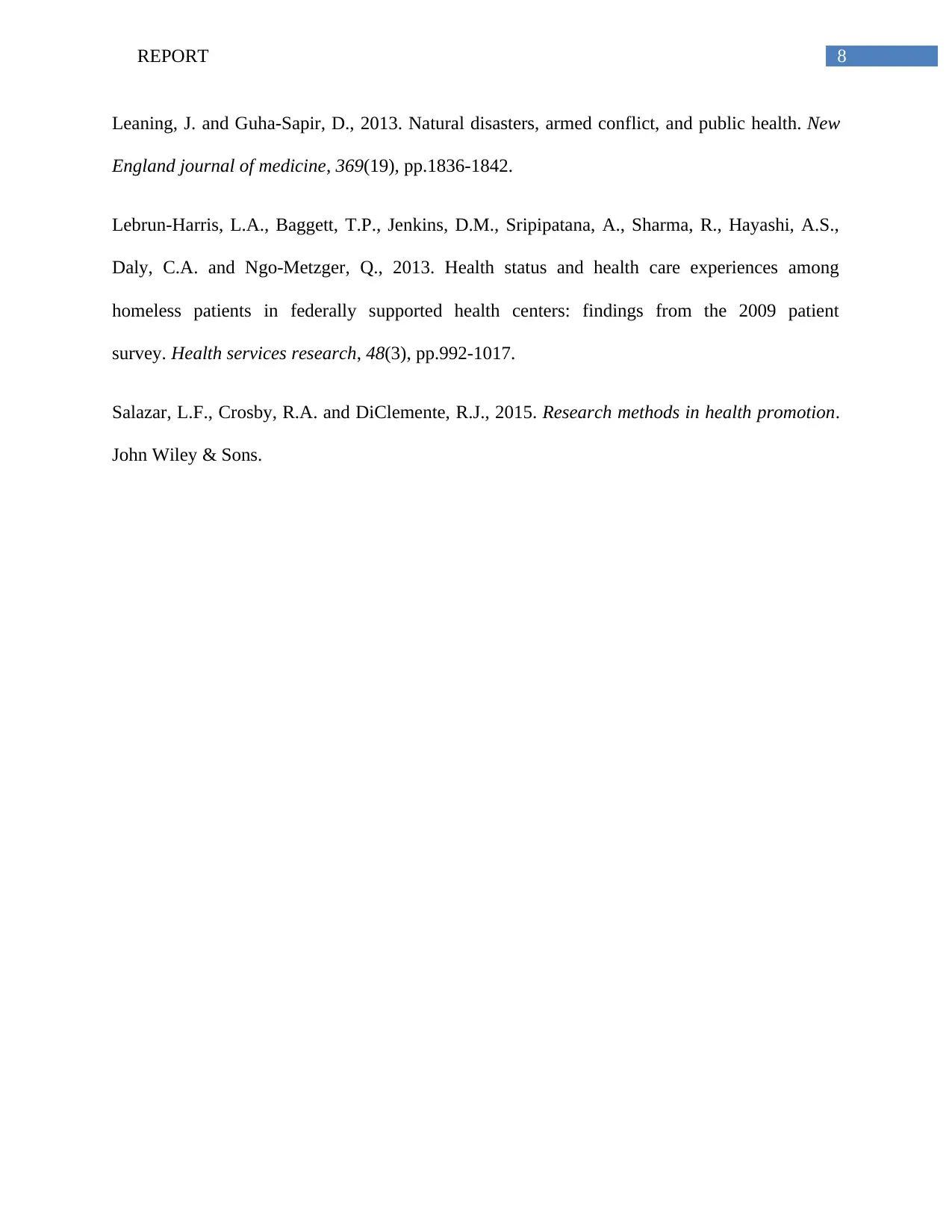
8REPORT
Leaning, J. and Guha-Sapir, D., 2013. Natural disasters, armed conflict, and public health. New
England journal of medicine, 369(19), pp.1836-1842.
Lebrun‐Harris, L.A., Baggett, T.P., Jenkins, D.M., Sripipatana, A., Sharma, R., Hayashi, A.S.,
Daly, C.A. and Ngo‐Metzger, Q., 2013. Health status and health care experiences among
homeless patients in federally supported health centers: findings from the 2009 patient
survey. Health services research, 48(3), pp.992-1017.
Salazar, L.F., Crosby, R.A. and DiClemente, R.J., 2015. Research methods in health promotion.
John Wiley & Sons.
Leaning, J. and Guha-Sapir, D., 2013. Natural disasters, armed conflict, and public health. New
England journal of medicine, 369(19), pp.1836-1842.
Lebrun‐Harris, L.A., Baggett, T.P., Jenkins, D.M., Sripipatana, A., Sharma, R., Hayashi, A.S.,
Daly, C.A. and Ngo‐Metzger, Q., 2013. Health status and health care experiences among
homeless patients in federally supported health centers: findings from the 2009 patient
survey. Health services research, 48(3), pp.992-1017.
Salazar, L.F., Crosby, R.A. and DiClemente, R.J., 2015. Research methods in health promotion.
John Wiley & Sons.
⊘ This is a preview!⊘
Do you want full access?
Subscribe today to unlock all pages.

Trusted by 1+ million students worldwide
1 out of 9
Related Documents
Your All-in-One AI-Powered Toolkit for Academic Success.
+13062052269
info@desklib.com
Available 24*7 on WhatsApp / Email
![[object Object]](/_next/static/media/star-bottom.7253800d.svg)
Unlock your academic potential
Copyright © 2020–2025 A2Z Services. All Rights Reserved. Developed and managed by ZUCOL.





